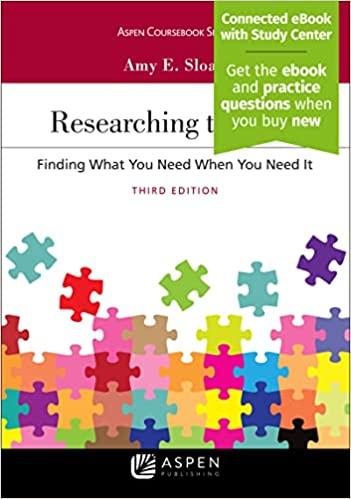Answered step by step
Verified Expert Solution
Question
1 Approved Answer
1. A police officer's actions based on probable cause in arresting an individual without a warrant is guided by the language of the 4thAmendment found
1. A police officer's actions based on probable cause in arresting an individual without a warrant is guided by the language of the 4thAmendment found in the: a. Warrant Clause b. Reasonableness Clause c. Attenuation Clause d. Exclusionary Clause 2. Plain feel or plain touch is permissible under the U.S. Supreme Court rule in Minnesota v. Dickerson provided there is no manipulation of the outer garment other than the initial pat-down pursuant to Terry v. Ohio. A. True B. False 3. Third party consent to search a residence can be given by someone present in the residence who has: a. been asked by the police for entry. b. acquiesced to the police presence. c. exhibited common authority over the residence to be searched. d. been tricked into allowing police entry. 4. According to the U.S. Supreme Court in California v. Hodari D. a suspect is not "seized" by police when police begin to chase, seizure only occurs when the suspect submits to police authority and the police exercise control over the suspect. A. True B. False 5. Which of the following is not a true statement with regard to stop & frisk procedure under the U.S. Supreme Court holding in Terry v. Ohio: a. police may frisk a person automatically upon any stop b. police can stop an individual on the street if they have a reasonable suspicion that the person may have committed a crime c. police can frisk an individual stopped on the street if they a separate reasonable suspicion that the individual possesses a weapon d. a frisk consists of a limited pat down of the outer part of the clothing of an individual stopped by police. 6. Third party consent to search the residence or vehicle of another person can never be given by a non-owner. A. True B. False 7. Police possessing an arrest warrant for an individual they arrest in the suspect's home can search the home for any weapons and evidence possessed by the suspect. A. True B. False 8. Which of the following is not considered a regulatory search or inspection: a. state alcohol and beverage control check at a bar b. employee drug testing c. fire safety inspections d. Terry v Ohio stops 9. Consent to search given to police must be based on a "voluntary and intelligent" waiver of an individual's constitutional rights. A. True B. False 10. There is a preference for warrants issued by judges rather than summary arrests or searches without a warrant because it interposes a neutral and detached magistrate between the individual and the authority of the government. A. True B. False 11. Inspections and regulatory searches can be based on a standard considered less than probable cause, this standard is one of: a. preponderance of the evidence b. reasonable suspicion c. hunches d. training and experience 12. A person under arrest can be searched incident to arrest and the area within the individual's immediate grabbable area may also be searched. A. True B. False 13. The Fourth Amendment test for the constitutionality of police use of force as articulated in the U.S. Supreme Court case Graham v. Connor is one of: a. probable cause b. police prerogative c. objective reasonableness d. subjective approachability 14. In a 1996 case, Ohio v. Robinette, the Court considered the issue as to whether or not the police had to provide a warning to an individual that they are "free to go" or not in custody prior to asking for consent to search. The Court emphatically said such a warning was not required. A. True B. False 15. A type of search warrant allowed by the U.S. Supreme Court which the Court has held are no different on their face than regular warrants, only that there must be probable cause that the "triggering condition" identified in the warrant will occur, are known as: a. sneak and peak warrants b. anticipatory search warrants c. USA Patriot Act search warrants d. eavesdropping warrants
Step by Step Solution
There are 3 Steps involved in it
Step: 1

Get Instant Access to Expert-Tailored Solutions
See step-by-step solutions with expert insights and AI powered tools for academic success
Step: 2

Step: 3

Ace Your Homework with AI
Get the answers you need in no time with our AI-driven, step-by-step assistance
Get Started


